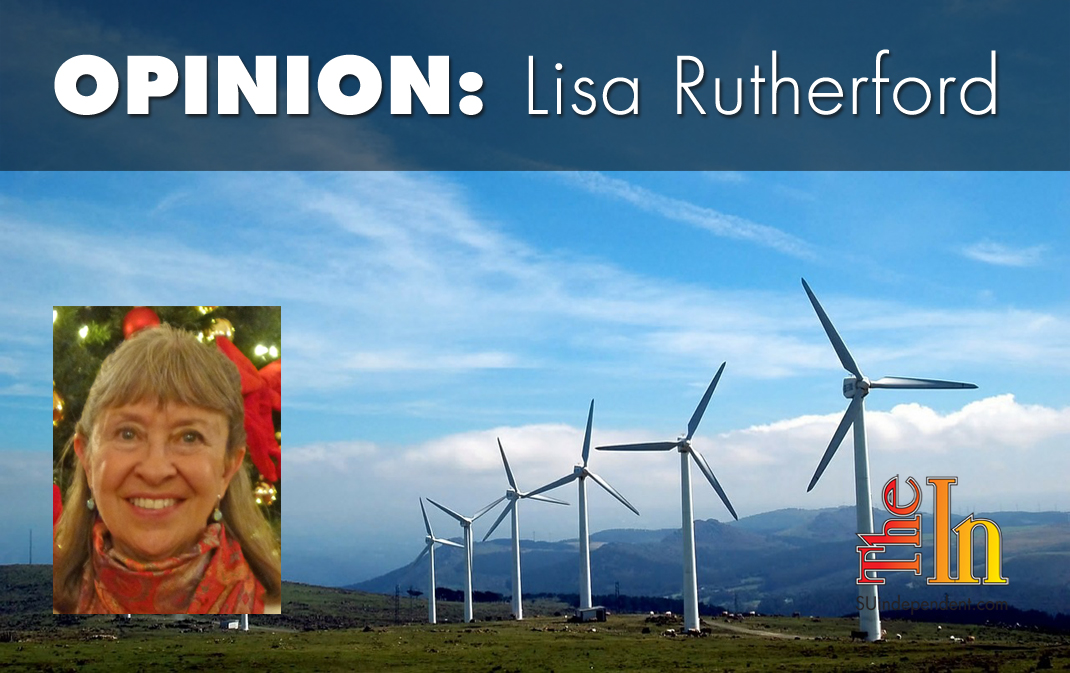
PacifiCorp and Rocky Mountain Power miss renewable energy opportunities
PacifiCorp and Rocky Mountain Power could save a lot of money by shifting from coal to renewable energy like wind and solar energy — but they’re not
On Aug. 17, I had the opportunity to participate in an event that opened my eyes even more than they already were to the opportunities we are missing for our energy future. Having worked for 20 years for an oil company and now serving on the board of Conserve Southwest Utah, I have perhaps a different and somewhat unique perspective on energy than others who merely use the product, some with abandon. The event was hosted by DOCUTAH and the Sierra Club. The purpose of the event was to showcase a film titled “Reinventing Power: America’s Renewable Energy Boom” followed by a three-person panel discussion in which I participated along with Tom Butine, representing Citizens Climate Lobby St. George, and Bob Ford, a Rockville rancher, researcher, and consultant.
The film takes viewers across the county from the East Coast to the West Coast and many points in between to see what communities large and small, urban and rural, progressive and conservative are doing with renewable energy. From former coal workers in North Carolina to former auto workers in Illinois and down-and-out citizens in California, out-of-work individuals are finding new lives in the renewable energy fields of wind and solar. Farmers in the Midwest are realizing benefits from using their land for wind, providing them with a stable income in a line of work that faces many challenges, particularly current global warming challenges. One small California town, Lancaster, had high unemployment and high crime but now has a new and vibrant life thanks to Build Your Dreams, a firm that built a 450,000-square-foot electric-bus manufacturing plant there. Build Your Dreams has been the world’s largest electric vehicle manufacturer for the past three years running with nearly 40,000 electric buses in service worldwide. At the heart of its business are batteries, the future of renewable energy.
The film provided an uplifting experience that is much needed during this time when environmental laws are being reviewed and revised by congressional members who enjoy strong fossil-fuel funding support. The film revealed that in spite of what’s going on in Washington D.C., communities across the nation are taking matters into their own hands. Renewable energy is helping to drive the economic boom that we’re witnessing, even while President Trump and others try to shut down renewables and subsidize fossil fuels. The U.S. Bureau of Labor Statistics (HTTPS://WWW.BLS.GOV/OOH/FASTEST-GROWING.HTM) lists 20 occupations with the highest percent change of employment in 2016–26. Photovoltaic installers lead the pack at a projected increase of 105 percent, and wind turbine technicians are second at 96 percent.
So how does this tie into PacifiCorp, the parent company of Rocky Mountain Power?
The Sierra Club commissioned a study by an independent energy consulting firm, Energy Strategies. The study used publicly available data to compare the present value of each of PacifiCorp’s coal units operating and capital costs against alternative energy options. The study did not examine capacity replacement, transmission expansion, operation impacts of replacement energy, or the extent to which replacements meet capacity or resources adequacy criteria. However, given that caveat, Energy Strategies asserts that the study is indicative of relative economic merit. The study is meant to engage the company in a meaningful discussion about the future of PacifiCorp’s coal fleet and the opportunities that are being lost as PacifiCorp continues to cling to coal energy.
The study should also serve to alert PacifiCorp’s customers to the fact that there is great potential for a cleaner future and cost savings for the company and its customers. PacifiCorp’s current energy mix contains 7 percent wind and .08 percent solar. More than 60 percent of the company’s energy comes from coal. Current market drivers such as energy efficiency, abundant and low natural gas prices, falling renewable energy costs, and environmental regulations that may or may not exist in the future make coal’s economic future look questionable.
The study reveals that 50 percent of PacifiCorp’s 24 coal units run at a higher cost when compared to solar and market energy purchases, and wind’s economics perform even better. Over their anticipated lives, 20 of the 24 coal units perform worse economically than wind energy, regardless of required pollution controls. The study contends that potential savings from displacing coal with solar or wind energy range from $600 million for solar to nearly $3 billion for wind.
What about Utah specifically?
Utah uses 44 percent of PacifiCorp’s mostly coal power. That’s a lot of coal, and it makes it quite clear why the coal lobby is so strong in Utah. So I guess Utah is just unable to break those ties that bind?
Well, let’s look at Texas. In spite of Texas having a longtime fossil-fuel focus, it is going green. Yes, you read correctly! Is its fossil-fuel lobby, which includes coal, less forceful than Utah’s coal lobby? Or are Texas leaders just more insightful?
The power grid in Texas is going green, and at an amazing rate. It’s expected that sometime in 2018 or 2019, total electricity from wind will be greater than coal in Texas. As for solar energy, a University of Texas-Austin study revealed that the state’s existing wind generation, along with 11 gigawatt of solar power, would meet electricity demand throughout the year. Huge solar projects are getting going in Texas. Five hundred-megawatt projects are being chatted up in the western part of the state.
Still, Texas is the largest coal-consuming state with the highest carbon and sulfur dioxide emissions in the nation. But it’s making progress. That’s the point. It leads the nation in wind-powered electricity generation, and solar energy development is heating up — literally and figuratively.
And then there’s New Mexico, another sunny but fossil-fuel-reliant state. New Mexico’s largest electric utility wants to join a wholesale trading market. The market allows participants to buy and sell energy to balance each other’s supply and demand needs, thus helping to reduce carbon emissions by using excess renewable energy rather than tapping other carbon-producing sources.
So- this brings me back to PacifiCorp and Rocky Mountain Power and the opportunities they may be missing. The Sierra Club’s study by Energy Strategies and the experiences of other fossil-fuel states reveal that the company seems to be ignoring options other than supporting Utah’s coal industry. There is much occurring across this nation that gives me hope that our energy future is more promising than it sometimes appears.
Energy politics in Utah should not be holding us back, but apparently is. In 2010, I met the mayor of Greensburg, Kansas, Mayor Dixson. Greensburg had been destroyed by a category five tornado in 2007. Ninety-five percent of the town was destroyed. As town leaders and citizens were determining their future, they decided to rebuild “green” and became the second city in the country to go entirely renewable, getting all electricity — plus some — from their wind farm. Mayor Dixson — a big, lanky man with a slow, cordial manner — made it clear: “It’s not a Republican or Democrat issue. It’s a human issue.”
Articles related to “PacifiCorp and Rocky Mountain Power miss renewable energy opportunities”
Five new energy technologies and their potential economic impact
The viewpoints expressed above are those of the author and do not necessarily reflect those of The Independent.
How to submit an article, guest opinion piece, or letter to the editor to The Independent
Do you have something to say? Want your voice to be heard by thousands of readers? Send The Independent your letter to the editor or guest opinion piece. All submissions will be considered for publication by our editorial staff. If your letter or editorial is accepted, it will run on suindependent.com, and we’ll promote it through all of our social media channels. We may even decide to include it in our monthly print edition. Just follow our simple submission guidelines and make your voice heard:
—Submissions should be between 300 and 1,500 words.
—Submissions must be sent to editor@infowest.com as a .doc, .docx, .txt, or .rtf file.
—The subject line of the email containing your submission should read “Letter to the editor.”
—Attach your name to both the email and the document file (we don’t run anonymous letters).
—If you have a photo or image you’d like us to use and it’s in .jpg format, at least 1200 X 754 pixels large, and your intellectual property (you own the copyright), feel free to attach it as well, though we reserve the right to choose a different image.
—If you are on Twitter and would like a shout-out when your piece or letter is published, include that in your correspondence and we’ll give you a mention at the time of publication.



